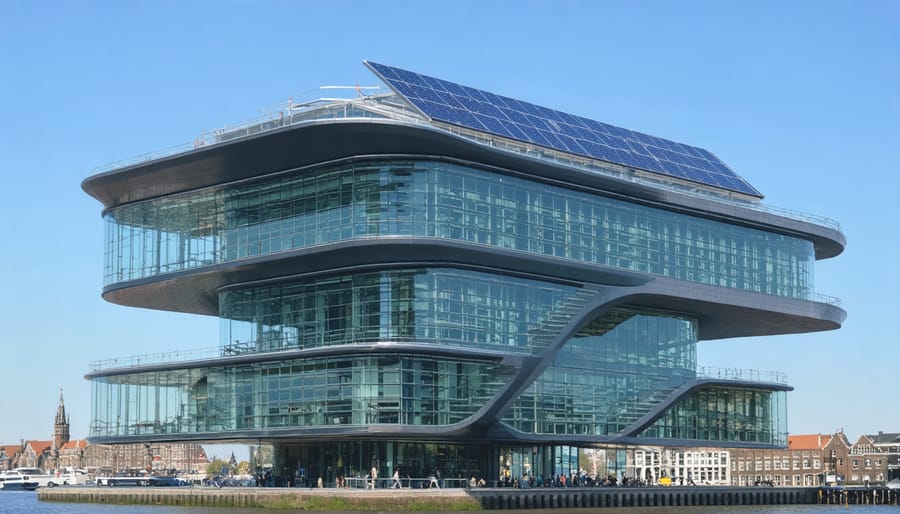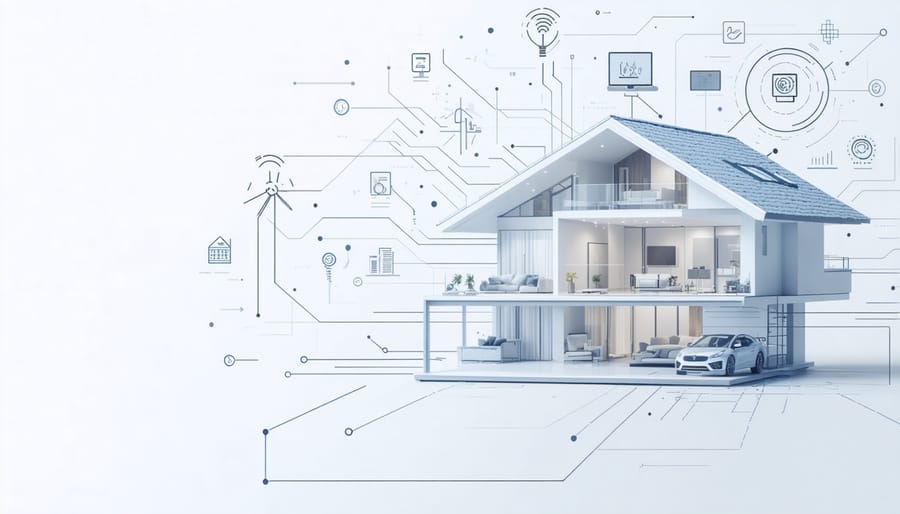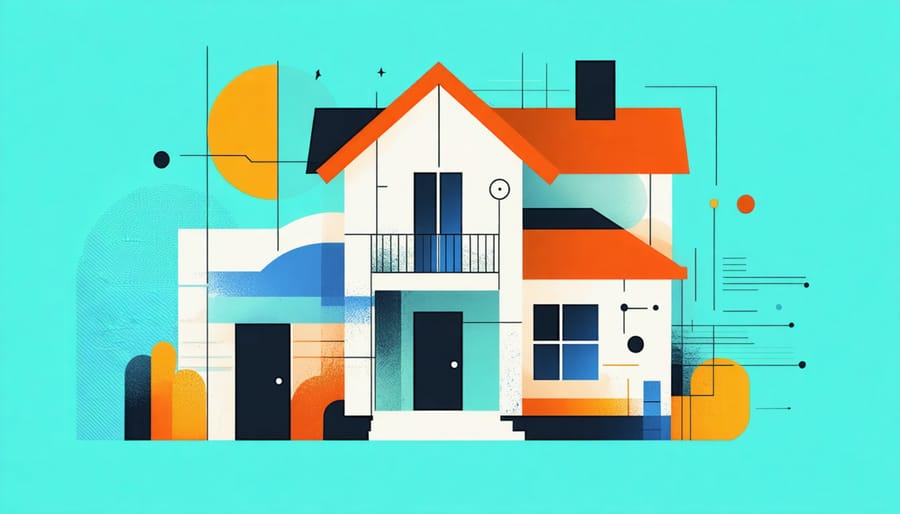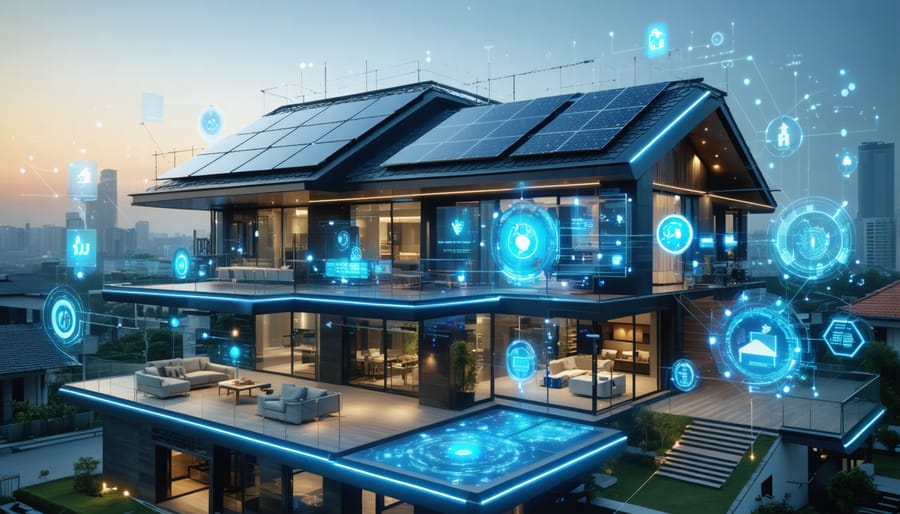Smart buildings have revolutionized modern architecture by seamlessly integrating intelligent energy systems with advanced automation technologies. The Edge in Amsterdam stands as a prime example, achieving unprecedented sustainability with its 28,000 sensors managing everything from occupancy to lighting levels. Singapore’s Capita Green demonstrates how biometric access control and predictive maintenance systems can reduce operational costs by 30% while enhancing security protocols. New York’s Empire State Building’s retrofit showcases how historical structures can be transformed into smart buildings, cutting energy consumption by 38% through integrated HVAC controls and real-time energy monitoring.
These pioneering implementations have established new benchmarks for building automation, energy efficiency, and occupant comfort. From adaptive lighting systems that respond to natural daylight to AI-powered HVAC systems that learn from occupant behavior, smart buildings are redefining how we interact with our built environment. For construction professionals and building owners, these examples provide crucial insights into the practical applications and tangible benefits of smart building technologies.

The Edge Building: Setting New Standards in Smart Home Technology
Advanced Energy Management Systems
The Edge’s groundbreaking energy management system has become a blueprint for modern residential energy management solutions. The building’s sophisticated network of sensors and automated controls has been successfully scaled down for residential applications, demonstrating remarkable efficiency gains in home environments.
Key features adapted from The Edge include AI-driven climate control systems that learn occupant preferences while optimizing energy consumption. These systems utilize predictive analytics to adjust heating and cooling based on weather forecasts, occupancy patterns, and thermal load calculations. Similar to The Edge’s implementation, residential versions incorporate smart meters and sub-metering capabilities to provide granular energy usage data.
The building’s innovative daylight harvesting system has been modified for home use, automatically adjusting artificial lighting based on natural light availability. Integration with smart home platforms enables seamless control through mobile applications, allowing homeowners to monitor and adjust energy consumption remotely.
Solar panel arrays, coupled with advanced energy storage solutions, mirror The Edge’s approach to renewable energy integration. Smart inverters and battery management systems optimize power distribution throughout the day, while automated load-shedding capabilities help reduce peak demand charges.
These adaptations demonstrate how commercial smart building technologies can be effectively scaled for residential applications, providing significant energy savings while maintaining occupant comfort.
IoT Integration and Real-time Monitoring
Modern smart buildings leverage extensive sensor networks and IoT devices to create an interconnected ecosystem that continuously monitors and optimizes building performance. These systems typically incorporate environmental sensors that track temperature, humidity, CO2 levels, and occupancy patterns in real-time. The data collected is processed through sophisticated analytics platforms, enabling building managers to make informed decisions about energy usage and facility operations.
For example, the Edge building in Amsterdam utilizes over 28,000 sensors that monitor movement, lighting levels, humidity, and temperature. These sensors communicate with a central building management system that automatically adjusts HVAC operations and lighting levels based on real-time occupancy and environmental conditions, resulting in a 70% reduction in energy consumption compared to traditional buildings.
The implementation of IoT devices extends beyond basic monitoring to include predictive maintenance capabilities. Smart sensors can detect equipment irregularities before they become critical issues, enabling proactive maintenance scheduling and reducing downtime. Advanced analytics platforms use machine learning algorithms to identify patterns in energy consumption and suggest optimization strategies.
Real-time monitoring systems also facilitate demand-response programs, allowing buildings to automatically adjust their energy consumption during peak grid periods. This capability not only reduces operational costs but also contributes to grid stability and sustainability goals. Building managers can access these insights through customized dashboards, providing immediate visibility into building performance metrics and enabling quick response to changing conditions.

The Bullitt Center: Zero Energy Living Made Real
Solar Integration and Energy Storage
Modern smart buildings are increasingly incorporating advanced solar integration and energy storage systems to achieve sustainability goals and reduce operational costs. The Edge building in Amsterdam exemplifies this approach, featuring 65,000 square feet of solar panels that work in conjunction with an advanced battery storage system, enabling the building to produce more energy than it consumes.
Battery storage solutions play a crucial role in maximizing solar energy utilization. The Bullitt Center in Seattle utilizes a sophisticated energy storage system that manages peak demand and provides backup power during outages. This integration allows the building to maintain net-zero energy status year-round, even in a climate with limited sunshine.
Leading manufacturers are developing smart inverters and management systems that optimize the flow between solar generation, storage, and building consumption. These systems use AI-driven algorithms to predict energy needs based on weather forecasts, occupancy patterns, and historical usage data.
The implementation of solar-plus-storage solutions typically delivers ROI within 5-7 years through reduced utility costs and demand charges. Notable examples include the San Francisco Public Utilities Commission headquarters, which combines a 277kW solar array with a 750kWh battery system, reducing grid dependency by up to 75% during peak hours.
Water Management and Heat Recovery
Modern smart buildings employ sophisticated water management and heat recovery systems that significantly reduce resource consumption while maximizing energy efficiency. Advanced water monitoring systems use IoT sensors to detect leaks, track usage patterns, and automatically adjust flow rates based on demand. These systems typically achieve 30-40% reduction in water consumption compared to conventional buildings.
Heat recovery ventilation (HRV) systems are increasingly becoming standard in smart buildings, capturing and recycling thermal energy that would otherwise be lost. By extracting heat from exhaust air and transferring it to incoming fresh air, these systems can recover up to 85% of heat energy. Notable implementations include the Edge building in Amsterdam, which utilizes aquifer thermal energy storage (ATES) to maintain optimal temperatures year-round.
Greywater recycling systems are another crucial component, treating and reusing water from sinks, showers, and washing machines for non-potable applications like toilet flushing and irrigation. The Bullitt Center in Seattle exemplifies this approach, featuring a closed-loop water system that processes 100% of its greywater on-site. These integrated systems are monitored and controlled through building management systems (BMS), enabling real-time adjustments and predictive maintenance to ensure optimal performance.
CopenHill: Smart Design Meets Residential Efficiency
Waste-to-Energy Systems
Waste-to-energy systems have evolved significantly, making them increasingly viable for residential applications. Modern smart buildings are incorporating scaled-down versions of industrial waste management solutions, transforming household waste into usable energy through various processes.
Anaerobic digestion systems, particularly suited for multi-family residences, can convert organic waste into biogas for heating and cooking. These systems typically process between 100-500 kg of organic waste daily, generating enough energy to supplement 15-20% of a building’s energy needs. The Edge building in Amsterdam demonstrates this concept effectively, utilizing food waste from its cafeteria to partially power its HVAC systems.
Thermal conversion technologies have also been adapted for residential use. Pyrolysis units, which process non-recyclable plastics and other combustible materials, can be installed in basement utility rooms, requiring approximately 50 square feet of space. These systems can generate both electricity and thermal energy, with modern units achieving conversion efficiencies of up to 85%.
Smart waste sorting systems, equipped with AI-powered sensors, automatically separate recyclables from organic waste, optimizing the waste-to-energy conversion process. This technology reduces contamination rates by up to 95% and increases energy yield by 30%. The Bosco Verticale in Milan exemplifies this integration, utilizing smart waste sorting to fuel its building-wide energy recovery system.
For implementation, buildings require dedicated waste collection infrastructure, energy storage solutions, and integration with existing power systems. The initial investment typically ranges from $50,000 to $200,000, with ROI achieved within 5-7 years through reduced energy costs and waste management fees.
Smart Grid Integration
Modern smart buildings are revolutionizing the way we interact with power infrastructure through advanced smart grid integration systems. These sophisticated buildings employ bi-directional communication with utility providers, enabling real-time monitoring and optimization of energy consumption patterns.
At the core of this integration are smart meters and advanced metering infrastructure (AMI) that facilitate automated meter reading, demand response capabilities, and dynamic pricing mechanisms. Buildings equipped with these systems can automatically adjust their energy usage based on grid conditions and electricity costs, participating in demand response programs that help stabilize the broader power network.
The integration architecture typically includes:
– Building Energy Management Systems (BEMS) that orchestrate power distribution
– Smart inverters for renewable energy systems
– Energy storage systems for load shifting
– Automated load shedding capabilities
– Real-time power quality monitoring
These components work in concert to enable features such as peak load management, renewable energy integration, and automated fault detection. For example, during peak demand periods, smart buildings can automatically reduce non-essential power consumption or switch to stored energy, helping to maintain grid stability while reducing operational costs.
The implementation of these systems has shown remarkable results, with many buildings achieving 15-25% reduction in energy costs while contributing to grid reliability and sustainability goals.
Implementation Strategies for Homeowners
Cost-Effective Solutions
Smart building technologies don’t always require substantial capital investment. Several cost-effective solutions can significantly enhance residential energy efficiency while maintaining a reasonable payback period. Programmable smart thermostats, for instance, typically cost between $150-300 and can reduce heating and cooling costs by 10-15% annually.
LED lighting systems with motion sensors and daylight harvesting capabilities represent another affordable entry point into smart building technology. These systems can reduce lighting energy consumption by up to 80% compared to traditional lighting, with installation costs often recovered within two years through reduced energy bills.
Smart power strips and energy monitoring systems, ranging from $30-200, provide detailed consumption data and automatically cut power to devices in standby mode, potentially saving hundreds of dollars annually. These devices offer valuable insights into energy usage patterns without requiring extensive infrastructure modifications.
Basic building automation systems starting at $500 can integrate these components while providing centralized control through smartphone applications. For enhanced efficiency, smart window films and automated blinds offer solar heat management at a fraction of the cost of window replacement, typically ranging from $7-15 per square foot.
Local utilities often provide rebates and incentives for implementing these technologies, further reducing initial costs. When combined with proper installation and regular maintenance, these solutions deliver reliable performance improvements while maintaining affordability for residential applications. Energy management consultants report that most homeowners can achieve significant efficiency gains with an initial investment under $2,000.

Future-Proofing Your Home
When implementing smart building technologies in residential settings, future-proofing your home requires careful planning and strategic decision-making. Begin by establishing a robust infrastructure that can accommodate technological advancements. This includes installing high-capacity electrical systems, comprehensive networking capabilities, and flexible automation frameworks that support multiple protocols.
Consider implementing a modular approach to smart systems, allowing for easy upgrades and expansions. Start with foundational elements such as smart meters, programmable thermostats, and basic automation controls. These core components should be selected based on their compatibility with major smart home standards and their ability to integrate with future technologies.
Energy management systems should be scalable, allowing for the integration of renewable energy sources like solar panels and battery storage systems. Install appropriate conduit and wiring pathways during initial construction or renovation to facilitate future additions of smart devices and sensors.
Security considerations are paramount when future-proofing. Implement cybersecurity measures that can be updated regularly, and choose devices with strong encryption capabilities. Consider installing dedicated networks for smart home systems to isolate them from potential security threats.
Documentation is crucial for long-term success. Maintain detailed records of system specifications, network configurations, and device locations. This information will prove invaluable when upgrading or troubleshooting systems in the future.
Work with qualified professionals who understand both current smart home technologies and emerging trends. They can help design systems that accommodate future innovations while meeting immediate needs, ensuring your investment remains valuable for years to come.
The integration of smart building technologies in residential applications represents a transformative shift in how we approach home construction and renovation. As demonstrated through various examples, these technologies consistently deliver improved energy efficiency, enhanced comfort, and superior building performance while providing tangible cost savings for homeowners.
The success stories we’ve examined highlight several critical factors for successful smart building implementation: comprehensive planning, seamless system integration, and user-focused design. These elements, combined with advancing IoT capabilities and artificial intelligence, create homes that are not just automated but truly intelligent and responsive to occupant needs.
Looking ahead, the residential smart building sector shows tremendous promise. Emerging technologies such as advanced machine learning algorithms, improved sensor networks, and more sophisticated energy management systems will further enhance the capabilities of smart homes. We can expect to see greater standardization of smart building protocols, making integration simpler and more cost-effective for homeowners.
However, the future of smart buildings extends beyond individual homes. The growing trend toward connected communities and smart cities suggests that residential smart building technologies will increasingly interface with broader urban systems, creating more sustainable and efficient living environments.
For construction professionals and homeowners alike, the message is clear: smart building technologies are no longer a luxury but a necessary consideration in modern residential construction and renovation projects. Their proven benefits in energy efficiency, comfort, and property value make them an essential component of future-ready homes.

